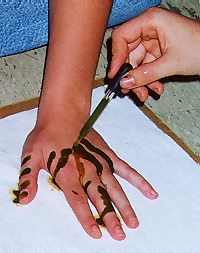|
Hand Land
 Hand Land offers students an opportunity to learn
through fun and simple observations complimented by inquiry-based
analysis. Students will learn the physical definition of a watershed:
by observing the general watershed characteristics of high, middle
and low topography
which are visible on one's own hand. In a watershed, water flows
from the high point to the low point terminating in a collective
source: a river, lake or ocean. In our Hand Land watershed, water
flows from the wrist downward, the bones in the back of one's outstretched
hand act as the divides,
or high points, delineating the watershed boundaries, causing water
to flow in either direction. One can typically observe water moving
in small streams down the hand towards the lowest elevation on the
edge of the hand or into one of the other watersheds, which lie,
between each finger.
Hand Land offers students an opportunity to learn
through fun and simple observations complimented by inquiry-based
analysis. Students will learn the physical definition of a watershed:
by observing the general watershed characteristics of high, middle
and low topography
which are visible on one's own hand. In a watershed, water flows
from the high point to the low point terminating in a collective
source: a river, lake or ocean. In our Hand Land watershed, water
flows from the wrist downward, the bones in the back of one's outstretched
hand act as the divides,
or high points, delineating the watershed boundaries, causing water
to flow in either direction. One can typically observe water moving
in small streams down the hand towards the lowest elevation on the
edge of the hand or into one of the other watersheds, which lie,
between each finger.
"The
main instrument of landscape sculpture is of course water, or shui.
Water not only carves the mountains or valleys physically but flows
through the earth conveying the chi. From the water, which flows
on the surface in stream, rivers, and pools, dragons rise into the
air, as the water itself evaporates. Wind or feng distributes the
water vapor as clouds which, taking the form of dragons in the air,
consolidate finally to precipitate life-giving rain onto mountains
which are the traditional lair of these dragons. The elements wind
and water are the essence of feng-shui, which affect the earth and
life on it."
--Stephen Skinner, The
Living Earth Manual of Feng-Shui
Targeted
Grade Level
Grades 5-7
Objectives
Students will:
|
- Experience
the movement of rainwater over land.
- Speculate
on the flow characteristics of rainfall.
- Explain
the concept of flow over a land.
- Explain
topographical representation.
- Explain
the boundary of watershed.
|
|
Activity
The back of the students' outstretched hands will act as the
model for this experiment. Students create a concentric drawing
of their hand to record their prediction and experiment with
water movement on this hand-model.
|
- Creating
a topographical model - your Hand Land
- Where
will the water go when it rains?
- Discovering
the movement of water in a watershed
- Finding
and defining a watershed boundary
|
Estimated
Duration
1 to 1.5 hours
PA
Educational Standards
Related PA Proposed Environment and Ecology Standards:
Grade 7
Watersheds
- Explain the water
cycle as it relates to a watershed
- Understand the role
of the watershed
- Identify and explain
what determines the boundaries of a watershed
|
![]()

 Hand Land offers students an opportunity to learn
through fun and simple observations complimented by inquiry-based
analysis. Students will learn the physical definition of a
Hand Land offers students an opportunity to learn
through fun and simple observations complimented by inquiry-based
analysis. Students will learn the physical definition of a